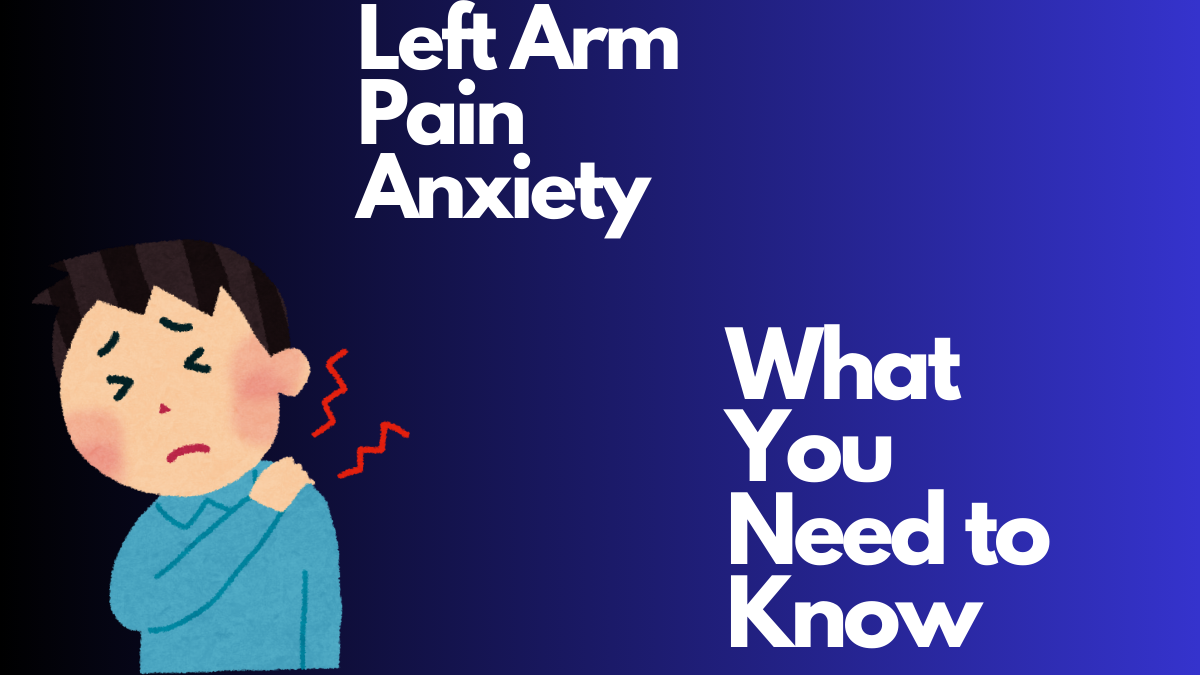Left arm discomfort can be a very upsetting symptom that often makes people fear the worst—a heart attack. It’s crucial to understand, too, that pain in the left arm may also be an indication of anxiousness. With insights from psychiatric professionals, this article explores the causes, symptoms, and therapies of left arm pain anxiety, guiding you in managing and comprehending this illness.

Table of Contents
Understanding Left Arm Pain Anxiety
What is left arm pain anxiety?
pain in the left arm Anxiety is not a physical condition, such as cardiac problems, but rather a feeling of pain or discomfort in the left arm that is directly linked to anxiety. Left arm pain is one of the many physical symptoms that can be brought on by anxiety. Due to the fact that the symptoms closely resemble those of more serious illnesses, this can cause great distress and confusion.
Why does anxiety cause left arm pain?
The physiological reaction of the body to stress can be used to explain the relationship between anxiety and pain in the left arm. The fight-or-flight reaction in the body is triggered when someone is anxious. Stress chemicals like adrenaline are released during this reaction, which can cause tense muscles, a faster heartbeat, and enhanced sensory sensitivity. Pain in the left arm might be a sign of muscle stress, especially in the arms, shoulders, and neck.
Symptoms of Left Arm Pain and Anxiety
It is essential to identify the signs of left arm pain anxiety in order to differentiate it from other possible causes. Typical signs and symptoms include:
Aching Pain: Anxiety-related arm pain is typically reported as dull and aching, as opposed to the intense pain of a heart attack.
Intermittent Pain: Periods of increased anxiety may correspond with intermittent episodes of pain.
Accompanied by other anxiety symptoms: Other symptoms that people may encounter include a racing heartbeat, perspiration, dyspnea, and a feeling of approaching disaster.
No Specific Physical Cause: Medical exams might not identify any underlying medical issues that could be the cause of the arm pain.
Psychological Insights on Left Arm Pain Anxiety
Expert Opinions
A certified clinical psychologist named Dr. Emily Roberts says, “A classic illustration of the connection between our minds and bodies is left arm discomfort and worry. Physical symptoms of anxiety can occur, so treating the psychological as well as the physical components of the illness is crucial for successful management.”
The Role of Cognitive-Behavioral Therapy (CBT)
CBT is a well-known method for treating anxiety-related disorders, such as anxiety associated with left arm pain. With the use of cognitive behavioral therapy (CBT), people can recognize and confront the harmful thought patterns that lead to anxiety and replace them with more balanced, healthy ideas. Consequently, this may lessen the physical manifestations of anxiety.
Differentiating Left Arm Pain Anxiety from Heart Attack
One of the biggest problems people have is telling the difference between a heart attack and left arm pain. There are certain significant distinctions to take into account, even though it’s always necessary to get medical help if in doubt:
Pain Type: Anxiety-related pain is typically dull and uncomfortable, whereas heart attack pain is frequently characterized as crushing or squeezing.
Pain Duration: Anxiety-related pain may vary according to anxiety levels, but heart attack pain is constant and can intensify.
Associated Symptoms: Anxiety-induced pain is less likely to be accompanied by other symptoms, including nausea, shortness of breath, and chest discomfort, than heart attacks.
Managing Left Arm Pain Anxiety
Relaxation Techniques
Using relaxation techniques can help reduce anxiety related to left arm pain dramatically. Techniques that ease tension in the muscles and foster serenity include gradual muscle relaxation, deep breathing techniques, and mindfulness meditation.
Exercise and physical activity
Frequent exercise has been shown to be an effective way to lower anxiety. Natural mood enhancers, called endorphins, are released during exercise. It also lessens the chance of experiencing symptoms brought on by worry by easing tense muscles and enhancing general physical wellness.
Healthy lifestyle choices
Keeping up a healthy lifestyle is essential for anxiety management. This comprises:
Balanced Diet: A healthy diet can have a favorable effect on mood, energy levels, and general health.
Adequate Sleep: Getting enough sleep is essential for both physical and mental health.
Limiting Stimulants: limiting or abstaining from stimulants like nicotine, caffeine, and other substances that might make anxiety worse.
Professional Help
Getting expert assistance is frequently required to effectively manage anxiety related to left arm pain. Treatment regimens that are specifically designed by a psychologist or therapist may include counseling and, if necessary, medication management.
Medication Options
Medication may be used in some circumstances to help control anxiety symptoms. Benzodiazepines, beta-blockers, and selective serotonin reuptake inhibitors (SSRIs) are common drugs. Collaborating closely with a healthcare professional is crucial to identifying the best course of action.
Real-Life Experiences
Case Study: Sarah’s Journey
The 34-year-old marketing executive, Sarah, was anxious because she had chronic discomfort in her left arm. Her agony remained even after several medical tests ruled out any cardiac problems. Sarah started CBT sessions and incorporated relaxation techniques into her everyday routine under the supervision of her psychologist. She eventually saw a noticeable decrease in the pain in her left arm and an improvement in her anxiety levels overall.
Testimonials
John, a 45-year-old teacher, says, “Every time I felt discomfort in my left arm, I was positive I was suffering a heart attack. Everything changed when I discovered the link between physical symptoms and anxiety. I’m now a lot better at managing my anxiety thanks to therapy and lifestyle modifications.”
Conclusion
pain in the left arm Anxiety is a prevalent yet frequently misdiagnosed illness. Comprehending the correlation between bodily symptoms and anxiety is vital for efficient handling. People can greatly lessen their anxiety-related left arm discomfort by identifying the symptoms, distinguishing them from more serious conditions, and putting tactics like exercise, relaxation techniques, and expert assistance into practice.
It’s crucial to get medical attention to rule out any significant diseases if you have left arm pain and are unsure of its explanation. On the other hand, being aware of the bodily manifestations of worry enables you to take proactive measures for improved mental and physical well-being.
Final Thoughts
It can be difficult to live with left arm pain and anxiety, but you can manage it and lessen its effects on your life if you have the correct information and assistance. Recall that assistance is available and that you are not alone. To enhance your well-being, put your mental health first, get expert advice, and adopt a healthy lifestyle.
Frequently Ask Questions(FAQ)
What is left arm pain anxiety?
pain in the left arm Rather than referring to a medical problem like a heart attack, anxiety is the feeling of pain or discomfort in the left arm. Because anxiety causes the body to go into stress mode, it can cause a number of physical symptoms, such as soreness in the left arm.
How can anxiety cause left arm pain?
The body releases stress chemicals like adrenaline when anxiety triggers the fight-or-flight response. These hormones can lead to left arm pain by causing muscle tension, particularly in the arms, shoulders, and neck.
What are the symptoms of left arm pain anxiety?
A dull, excruciating pain in the left arm is one of the symptoms. Other anxiety-related symptoms include perspiration, shortness of breath, a fast heartbeat, and a sensation of impending doom. The discomfort also flares up and off.
How can I tell the difference between left arm pain anxiety and a heart attack?
Chest pain, nausea, and shortness of breath are sometimes experienced in conjunction with heart attack symptoms, which are frequently constant, crushing, or squeezing. Usually dull, painful, and sporadic, anxiety-related pain frequently coexists with other anxiety-related symptoms.
What should I do if I experience left arm pain anxiety?
If you’re not sure if the pain in your left arm is from a heart attack or anxiety, get help right away to rule out more serious diseases. If anxiety is determined to be the root of the problem, try putting relaxation techniques into practice, getting some exercise, and getting expert assistance.
How can relaxation techniques help with left arm pain anxiety?
Deep breathing exercises, progressive muscle relaxation, and mindfulness meditation are examples of relaxation practices that can ease tension in the muscles and create a calmer, more relaxed state, which can help with left arm discomfort and anxiety.
Can exercise help reduce left arm pain anxiety?
Yes, engaging in regular physical activity helps produce endorphins, which are naturally occurring mood enhancers. It also helps lower anxiety levels generally and in muscles, which may help lessen anxiety related to left arm pain.
What role does a psychologist play in managing left arm pain anxiety?
A psychologist can offer individualized treatment programs that include cognitive-behavioral therapy (CBT) to address maladaptive thought processes and lifestyle modifications and relaxation methods to control physical symptoms of anxiety.
Are there medications available for left arm pain anxiety?
To help control anxiety symptoms, doctors may occasionally prescribe drugs such as beta-blockers, benzodiazepines, or selective serotonin reuptake inhibitors (SSRIs). Speak with a medical professional to find the best course of action.
Can lifestyle changes help manage left arm pain anxiety?
Yes, you can dramatically lower anxiety levels and lessen the likelihood of left arm pain anxiety by leading a healthy lifestyle that includes a balanced diet, enough sleep, and moderation in stimulants like caffeine and tobacco.

